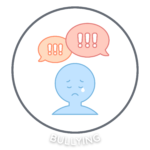
Cyberbullying is a significant issue affecting middle school students, with serious implications for their emotional and mental well-being. As a middle school counselor, you play a crucial role in educating students about cyberbullying and providing them with the tools to handle and prevent it. This blog post will guide you through a comprehensive lesson plan designed to support you teaching middle schoolers about cyberbullying, its impacts, and effective ways to address it. By following these steps, you can help your students navigate the digital world safely.
Understanding Cyberbullying
Cyberbullying involves intentionally harming someone through digital platforms such as social media, texting, and online forums. It can take various forms, including:
- Spreading rumors: Sharing false information to damage someone’s reputation.
- Writing mean comments: Posting hurtful messages online.
- Posting embarrassing pictures: Sharing images to humiliate someone.
- Creating fake accounts: Making accounts to impersonate and harm others.
Lesson Plan: Teaching Middle Schoolers About Cyberbullying
Objective
By the end of the lesson, students will understand what cyberbullying is, its impact, and how to support victims and address bullies effectively.
Materials Needed
- Whiteboard and markers
- Reflection journals or notebooks
- Printable activity worksheets (optional)
Duration
45-60 minutes
Activity Steps
Part A: Understanding Cyberbullying Through Stories (20 minutes)
Instructions: Ask students to create fictional stories for each type of cyberbullying. This exercise helps them recognize different forms of cyberbullying and its effects.
- Spreading Rumors: A student creates a fake rumor about a classmate’s family situation and shares it on social media. The rumor quickly spreads, causing the victim to feel isolated and distressed.
- Writing a Mean Comment: Another student posts a cruel comment about a classmate’s appearance on their Instagram photo, leading to a stream of negative replies.
- Posting an Embarrassing Picture: A student shares an unflattering photo of a classmate without their permission, leading to public embarrassment.
- Creating a Fake Account: A student makes a fake social media account pretending to be a classmate, using it to post inappropriate messages and create trouble for the victim.
Discussion: After creating these stories, discuss how each situation makes the victim feel. Highlight the emotional and psychological impact of each type of cyberbullying.
Part B: Comforting the Victim (15 minutes)
Instructions: Using the stories created, ask students to think about how they would comfort someone hurt by cyberbullying.
- Spreading Rumors: Offer reassurance and support, emphasizing that the rumors are false and that the victim is not alone.
- Writing a Mean Comment: Encourage the victim to talk about their feelings and remind them of their strengths and positive qualities.
- Posting an Embarrassing Picture: Help the victim feel better by acknowledging their feelings and suggesting steps to address the situation, like reporting the image.
- Creating a Fake Account: Support the victim in taking action, such as reporting the fake account and encouraging them to seek help from trusted adults.
Discussion: Encourage students to share their comfort strategies and discuss why it’s important to support victims of cyberbullying. Reinforce the value of empathy and solidarity.
Part C: Addressing the Bully (10 minutes)
Instructions: Ask students to think about what they would say to the person who cyberbullied others.
- Spreading Rumors: Explain the harm caused by spreading false information and encourage the bully to apologize and make amends.
- Writing a Mean Comment: Discuss the impact of hurtful comments and suggest ways the bully can change their behavior and support others.
- Posting an Embarrassing Picture: Highlight the damage caused by sharing private images and encourage the bully to take down the photo and apologize.
- Creating a Fake Account: Explain the seriousness of impersonation and encourage the bully to delete the fake account and understand the consequences of their actions.
Discussion: Facilitate a conversation about why it’s important to address bullies and hold them accountable for their actions. Discuss the importance of promoting a positive and respectful online environment.
Unlock all of our Cyber Skills materials by signing up for your free trial today – no credit card required!
Access the full Social Communication Curriculum HERE!
Instant access to thousands of no-prep social skills activities, over 1000+ video lessons, and engaging games designed to enhance learning and development.
Conclusion
Teaching middle school students about cyberbullying is essential for their safety and well-being. By using the activities and strategies outlined in this blog post, counselors can effectively educate students about the different forms of cyberbullying, how to support victims, and how to address bullies. For more resources and tips on teaching middle schoolers about cyberbullying, stay tuned to our blog.
Sample Video
Try out this sample animated video lesson.
We offer our entire Social-Emotional Learning platform free for 14 days here!
Related Blog Posts:
Navigating Middle School: Enhancing Social Skills Through Videos
Teaching Middle School Students to Stay Calm and Solve Problems
Promoting Mental Well-being: SEL Lessons for Middle School Students





